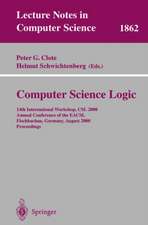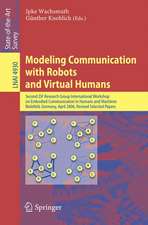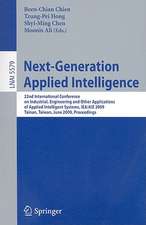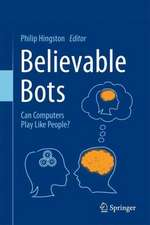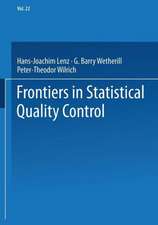Advances in Intelligent Data Analysis V: 5th International Symposium on Intelligent Data Analysis, IDA 2003, Berlin, Germany, August 28-30, 2003, Proceedings: Lecture Notes in Computer Science, cartea 2810
Editat de Michael R. Berthold, Hans-Joachim Lenz, Elizabeth Bradley, Rudolf Kruse, Christian Borgelten Limba Engleză Paperback – 21 aug 2003
Din seria Lecture Notes in Computer Science
- 20%
 Preț: 1061.55 lei
Preț: 1061.55 lei - 20%
 Preț: 307.71 lei
Preț: 307.71 lei - 20%
 Preț: 438.69 lei
Preț: 438.69 lei - 20%
 Preț: 579.30 lei
Preț: 579.30 lei -
 Preț: 410.88 lei
Preț: 410.88 lei - 17%
 Preț: 427.22 lei
Preț: 427.22 lei - 20%
 Preț: 596.46 lei
Preț: 596.46 lei - 15%
 Preț: 448.04 lei
Preț: 448.04 lei - 20%
 Preț: 353.50 lei
Preț: 353.50 lei -
 Preț: 389.49 lei
Preț: 389.49 lei - 20%
 Preț: 309.90 lei
Preț: 309.90 lei - 20%
 Preț: 645.28 lei
Preț: 645.28 lei - 20%
 Preț: 763.23 lei
Preț: 763.23 lei - 15%
 Preț: 580.46 lei
Preț: 580.46 lei - 20%
 Preț: 310.28 lei
Preț: 310.28 lei - 20%
 Preț: 655.02 lei
Preț: 655.02 lei - 20%
 Preț: 1183.14 lei
Preț: 1183.14 lei - 20%
 Preț: 340.32 lei
Preț: 340.32 lei -
 Preț: 449.57 lei
Preț: 449.57 lei - 20%
 Preț: 591.51 lei
Preț: 591.51 lei - 18%
 Preț: 938.83 lei
Preț: 938.83 lei - 20%
 Preț: 337.00 lei
Preț: 337.00 lei - 20%
 Preț: 649.50 lei
Preț: 649.50 lei - 20%
 Preț: 607.40 lei
Preț: 607.40 lei - 20%
 Preț: 1414.79 lei
Preț: 1414.79 lei - 20%
 Preț: 1024.44 lei
Preț: 1024.44 lei - 20%
 Preț: 583.40 lei
Preț: 583.40 lei - 20%
 Preț: 453.32 lei
Preț: 453.32 lei - 20%
 Preț: 575.49 lei
Preț: 575.49 lei - 20%
 Preț: 1075.26 lei
Preț: 1075.26 lei - 20%
 Preț: 585.88 lei
Preț: 585.88 lei - 20%
 Preț: 825.93 lei
Preț: 825.93 lei - 17%
 Preț: 360.20 lei
Preț: 360.20 lei - 20%
 Preț: 763.23 lei
Preț: 763.23 lei - 20%
 Preț: 340.32 lei
Preț: 340.32 lei - 20%
 Preț: 504.58 lei
Preț: 504.58 lei - 20%
 Preț: 369.13 lei
Preț: 369.13 lei - 20%
 Preț: 580.93 lei
Preț: 580.93 lei - 20%
 Preț: 343.62 lei
Preț: 343.62 lei - 20%
 Preț: 350.21 lei
Preț: 350.21 lei - 20%
 Preț: 583.40 lei
Preț: 583.40 lei - 20%
 Preț: 583.40 lei
Preț: 583.40 lei - 15%
 Preț: 438.59 lei
Preț: 438.59 lei - 20%
 Preț: 341.95 lei
Preț: 341.95 lei - 20%
 Preț: 238.01 lei
Preț: 238.01 lei - 20%
 Preț: 538.30 lei
Preț: 538.30 lei
Preț: 662.80 lei
Preț vechi: 828.50 lei
-20% Nou
Puncte Express: 994
Preț estimativ în valută:
126.84€ • 131.94$ • 104.72£
126.84€ • 131.94$ • 104.72£
Carte tipărită la comandă
Livrare economică 14-28 aprilie
Preluare comenzi: 021 569.72.76
Specificații
ISBN-13: 9783540408130
ISBN-10: 3540408134
Pagini: 648
Ilustrații: XVI, 632 p.
Dimensiuni: 155 x 235 x 34 mm
Greutate: 0.89 kg
Ediția:2003
Editura: Springer Berlin, Heidelberg
Colecția Springer
Seria Lecture Notes in Computer Science
Locul publicării:Berlin, Heidelberg, Germany
ISBN-10: 3540408134
Pagini: 648
Ilustrații: XVI, 632 p.
Dimensiuni: 155 x 235 x 34 mm
Greutate: 0.89 kg
Ediția:2003
Editura: Springer Berlin, Heidelberg
Colecția Springer
Seria Lecture Notes in Computer Science
Locul publicării:Berlin, Heidelberg, Germany
Public țintă
ResearchCuprins
Machine Learning.- Pruning for Monotone Classification Trees.- Regularized Learning with Flexible Constraints.- Learning to Answer Emails.- A Semi-supervised Method for Learning the Structure of Robot Environment Interactions.- Using Domain Specific Knowledge for Automated Modeling.- Resolving Rule Conflicts with Double Induction.- A Novel Partial-Memory Learning Algorithm Based on Grey Relational Structure.- Constructing Hierarchical Rule Systems.- Text Categorization Using Hybrid Multiple Model Schemes.- Probability and Topology.- Learning Dynamic Bayesian Networks from Multivariate Time Series with Changing Dependencies.- Topology and Intelligent Data Analysis.- Coherent Conditional Probability as a Measure of Information of the Relevant Conditioning Events.- Very Predictive Ngrams for Space-Limited Probabilistic Models.- Interval Estimation Naïve Bayes.- Mining Networks and Central Entities in Digital Libraries. A Graph Theoretic Approach Applied to Co-author Networks.- Classification and Pattern Recognition.- Learning Linear Classifiers Sensitive to Example Dependent and Noisy Costs.- An Effective Associative Memory for Pattern Recognition.- Similarity Based Classification.- Numerical Attributes in Decision Trees: A Hierarchical Approach.- Similarity-Based Neural Networks for Applications in Computational Molecular Biology.- Combining Pairwise Classifiers with Stacking.- APRIORI-SD: Adapting Association Rule Learning to Subgroup Discovery.- Solving Classification Problems Using Infix Form Genetic Programming.- Clustering.- What Is Fuzzy about Fuzzy Clustering? Understanding and Improving the Concept of the Fuzzifier.- A Mixture Model Approach for Binned Data Clustering.- Fuzzy Clustering Based Segmentation of Time-Series.- An Iterated Local Search Approach forMinimum Sum-of-Squares Clustering.- Data Clustering in Tolerance Space.- Refined Shared Nearest Neighbors Graph for Combining Multiple Data Clusterings.- Clustering Mobile Trajectories for Resource Allocation in Mobile Environments.- Fuzzy Clustering of Short Time-Series and Unevenly Distributed Sampling Points.- Combining and Comparing Cluster Methods in a Receptor Database.- Applications.- Selective Sampling with a Hierarchical Latent Variable Model.- Obtaining Quality Microarray Data via Image Reconstruction.- Large Scale Mining of Molecular Fragments with Wildcards.- Genome-Wide Prokaryotic Promoter Recognition Based on Sequence Alignment Kernel.- Towards Automated Electrocardiac Map Interpretation: An Intelligent Contouring Tool Based on Spatial Aggregation.- Study of Canada/US Dollar Exchange Rate Movements Using Recurrent Neural Network Model of FX-Market.- Gaussian Mixture Density Estimation Applied to Microarray Data.- Classification of Protein Localisation Patterns via Supervised Neural Network Learning.- Applying Intelligent Data Analysis to Coupling Relationships in Object-Oriented Software.- The Smaller the Better: Comparison of Two Approaches for Sales Rate Prediction.- Modeling.- A Multiagent-Based Constructive Approach for Feedforward Neural Networks.- Evolutionary System Identification via Descriptive Takagi Sugeno Fuzzy Systems.- Minimum Message Length Criterion for Second-Order Polynomial Model Selection Applied to Tropical Cyclone Intensity Forecasting.- On the Use of the GTM Algorithm for Mode Detection.- Regularization Methods for Additive Models.- Automated Detection of Influenza Epidemics with Hidden Markov Models.- Guided Incremental Construction of Belief Networks.- Distributed Regression for Heterogeneous Data Sets.- (Data) Preprocessing.- ALogical Formalisation of the Fellegi-Holt Method of Data Cleaning.- Compression Technique Preserving Correlations of a Multivariate Temporal Sequence.- Condensed Representations in Presence of Missing Values.- Measures of Rule Quality for Feature Selection in Text Categorization.- Genetic Approach to Constructive Induction Based on Non-algebraic Feature Representation.- Active Feature Selection Based on a Very Limited Number of Entities.
Caracteristici
Includes supplementary material: sn.pub/extras










